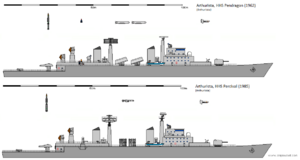Pendragon-class destroyer: Difference between revisions
old>Arthurista m (→Air defence) |
Ozycaevias (talk | contribs) m (1 revision imported: Ajax category without templates) |
(No difference)
| |
Latest revision as of 02:55, 11 January 2019

| |
| Class overview | |
|---|---|
| Name: | Pendragon-class destroyer |
| Builders: | Vickers Armstrong Arthurista |
| Operators: | Commonwealth Navy |
| Preceded by: | Paladin-class destroyer |
| Succeeded by: | Phobos-class destroyer, Type-44 destroyer |
| General characteristics | |
| Type: | Destroyer |
| Displacement: | 4,277 -5,600 tonnes |
| Length: | 156.2m |
| Beam: | 16m |
| Draught: | 5.7m full load |
| Propulsion: | 4x boilers, 2x steam turbines, 2-shafts, 60,000 shp |
| Speed: | 33kn |
| Range: | 9,300km at 20 knots |
| Armament: |
|
| Armour: | steel shrapnel sheets, kevlar spall liners |
The Pendragon class was Arthurista's first guided missile warship design, produced from 1959-1965. It was intended to replace 40s-era destroyers and cruisers with a single hybrid cruiser/destroyer design, capable of acting as a fast AAW/ASW escort for carrier groups or leading surface action groups on its own, being equipped with facilities for a flag officer's staff for this purpose.
Air defence
The Pendragon was designed, first and foremost, as an area air defence platform. A new weapon, the Sea Dog missile, was designed specifically for the ship. Early models were 'beam-riders' with a range of 45km. This was replaced by a semi-active radar homing Mk 2 variant in the mid-60s which extended its range to 60km and extending their service ceiling to 24.5km. An improved rocket motor increased its speed to roughly mach 3. The Sea Dog was also capable of attacking surface targets.
The Sea Dog possessed significant payload capacity at 100kg. They were armed with either a high explosive fragmentation warhead or a 1-kiloton nuclear warhead.
Pendragons were comprehensively modernised in the late-70s. The new Sea Dog Mk 3 is equipped with all-new inertial and datalink-based mid course guidance systems. Together with the use of improved rocket fuel in its booster stage, this increased its range even further to 75km. Improvements to the fire control radar units meant that illumination was only required in the terminal flight stage instead of all the way to the target, allowing a Pendragon-class vessel to control multiple missiles in the air simultaneously. Furthermore, a new combat data system allows these ships to network and share targeting data with other vessels in the flotilla, dramatically improving their survivability under air attack. A new Electronic Support Module allowed these ships to detect, sample and jam hostile radar seekers.
The Pendragon was also fitted with a variety of short-ranged AA weapons, from small-calibre autocannons to the Sea Cat system. The latter were replaced by Phalanx CIWS in the 1980s.
ASW and surface warfare armaments
Pendragons required a potent surface warfare capability, given their intended role as replacements for cruisers in controlling far-off foreign stations. The Greenwich Hammerhead anti-ship missile, designed to give them firepower equivalent to a battleship's 16-inch salvo, was fitted in two trainable triple launch bins amidships. Early versions utilised a liquid-fuelled rocket motor and could carry a 400kg warhead up to 40km, while late-60s era solid-fuelled versions could reach 80km. With these missiles, the Pendragon could comfortably take on cruiser-type vessels and win the subsequent surface action, allowing the admiralty to retire and mothball large numbers of 40s-era cruisers.
After 1977, the Greenwich Hammerhead missiles would be replaced by the ACM-2 Renove sea-skimmer.
In front of the bridge is an Ikara ASW missile system, fitted in lieu of an anti-submarine helicopter. It is backed up with a Limbo anti-submarine mortar system for close range anti-submarine defence (replaced in turn in the 80s in favour of a pair of trainable triple torpedo tubes).
In an emergency, the Sea Dog and Ikara missile systems are capable of launching tactical nuclear weapons at surface or submarine targets respectively.
Retirement
Despite their age, due to extended delays in the development of a new class of air-warfare destroyers, the Pendragon class was kept in service for much longer than envisaged. Vessels of the Pendragon-class remained mothballed in mobilisation storage until the mid-2000's.